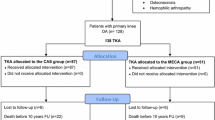Abstract
One of the main factors affecting the survival of a total knee arthroplasty (TKA) is the fixation method. The constraints placed on the bone–implant interface of a mobile-bearing TKA must be taken in account during the design and evaluation phases. For more than two decades, calcium phosphate ceramics, particularly hydroxyapatitis, have been used in Europe to accelerate the bone integration of cementless implants. A prospective study of patients continuously recruited by three senior surgeons at three French private hospitals has been carried out. There were no exclusion criteria. Eighty-four (84) cementless mobile-bearing total knee prosthesis of the brand “New Wave” were implanted in 74 patients over a 2-year period (2004–2005). Implant survival at 8 years was 95 % [with a confidence interval of 95 %: 80.2–96.4 %] when revision for any cause was defined as the endpoint. Five implants required surgical revision to exchange all or part of the implant: two for aseptic loosening of tibial component, one for osteolysis, one for persistent flessum (30°) and one for tibial periprosthetic fracture. Completely integrated implants and event-free outcomes were recorded in 91.4 % of the cases at eight-year follow-up. The Hospital for Special Surgery score significantly improved from 56.8/100 points before the surgery to 83.9/100 points at the last follow-up (p < 0.05). Radiologically, only one patient had radiolucent lines around the tibial and femoral components. This cementless total knee prosthesis yielded good medium-term survival. Cementless arthroplasty can generate solid and durable bone fixation in this total weight-bearing implant, and it seems that the hidroxyapathitis surface in this series stimulate the bone integration at the bone–implant interface.




Similar content being viewed by others
References
Buechel FF Sr (2002) Long-term followup after mobile-bearing total knee replacement. Clin Orthop Relat Res 404:40–50
Sorrells RB, Voorhorst PE, Murphy JA, Bauschka MP, Greenwald AS (2004) Uncemented rotating-platform total knee replacement: a five to twelve-year follow-up study. J Bone Joint Surg Am 86:2156–2162
Frayssinet P, Hardy D, Hanker JS, Guiammara BL (1995) Natural history of bone response to hydroxyapatite-coated hip prostheses implanted in humans. Cells Mater 5:125–138
Epinette JA, Manley MT (2008) Is hydroxyapatite a reliable fixation option in unicompartmental knee arthroplasty? A 5- to 13-year experience with the hydroxyapatite-coated unix prosthesis. J Knee Surg 21:299–306
Ochs U, Eingartner C, Volkmann R, Ochs BG, Huber C, Weller S, Weise K (2007) Prospective long-term follow-up of the cementless bicontact hip stem with plasmapore coating. Z Orthop Unfall 145(Suppl 1):S3–S8
Munting E (1994) Géométrie et caractéristiques de surface des implants : deux aspects indissociables de la fixation prothétique. In Expansion Scientifique Française (ed.) Cahiers d’enseignement de la SOFCOT—Hydroxyapatite et prothèses articulaires. Paris, pp. 13–19
Insall J, Ranawat CS, Scott WN, Walker P (1976) Total condylar knee replacement: preliminary report. Clin Orthop Relat Res 120:149–154
Argenson JN, Boisgard S, Parratte S, Descamps S, Bercovy M, Bonnevialle P, Briard JL, Brilhault J, Chouteau J, Nizard R, Saragaglia D, Servien E (2013) Survival analysis of total knee arthroplasty at a minimum 10 years’ follow-up: a multicenter French nationwide study including 846 cases. Orthop Traumatol Surg Res 99:385–390
Petersen MM, Nielsen PT, Lebech A, Toksvig-Larsen S, Lund B (1999) Preoperative bone mineral density of the proximal tibia and migration of the tibial component after uncemented total knee arthroplasty. J Arthroplasty 14:77–81
Sorrells RB, Stiehl JB, Voorhorst PE (2001) Midterm results of mobile-bearing total knee arthroplasty in patients younger than 65 years. Clin Orthop Relat Res 390:182–189
Nilsson KG, Karrholm J, Carlsson L, Dalen T (1999) Hydroxyapatite coating versus cemented fixation of the tibial component in total knee arthroplasty: prospective randomized comparison of hydroxyapatite-coated and cemented tibial components with 5-year follow-up using radiostereometry. J Arthroplasty 14:9–20
Kim YH, Park JW, Lim HM, Park ES (2014) Cementless and cemented total knee arthroplasty in patients younger than fifty five years. Which is better? Int Orthop 38(2):297–303
Arnold JB, Walters JL, Solomon LB, Thewlis D (2013) Does the method of component fixation influence clinical outcomes after total knee replacement? A systematic literature review. J Arthroplasty 28:740–746
Conflict of interest
Xavier Normand, Jean-Louis Pinçon and Jean-Marie Ragot are consultants of groupe Lépine. Thierry Aslanian and Régis Verdier are employed by groupe Lépine.
Ethical standard
This study has been conducted in accordance with French regulations.
Author information
Authors and Affiliations
Corresponding author
Rights and permissions
About this article
Cite this article
Normand, X., Pinçon, JL., Ragot, JM. et al. Prospective study of the cementless “New Wave” total knee mobile-bearing arthroplasty: 8-year follow-up. Eur J Orthop Surg Traumatol 25, 349–354 (2015). https://doi.org/10.1007/s00590-014-1484-2
Received:
Accepted:
Published:
Issue Date:
DOI: https://doi.org/10.1007/s00590-014-1484-2




